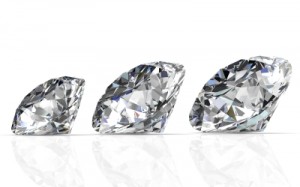 Last month we discussed the first “C” in the Four C’s: “cut,” and we learned its importance on determining the brilliance and ultimate beauty of a diamond. This month we’d like to provide you with the inside scoop on the “clarity” of a diamond: something we can not only tell you about, here, but will be happy to demonstrate for you if you stop in.
Last month we discussed the first “C” in the Four C’s: “cut,” and we learned its importance on determining the brilliance and ultimate beauty of a diamond. This month we’d like to provide you with the inside scoop on the “clarity” of a diamond: something we can not only tell you about, here, but will be happy to demonstrate for you if you stop in.
Although the Four C’s were established in the 1940’s as the international diamond grading system, it wasn’t until 1952 that the G.I.A. clarity grading scale was developed to create consistency within the industry when describing a diamond’s clarity.
Clarity is the term used to describe the number of inclusions or blemishes within a diamond. Inclusions are the internal makeup of a diamond, which might include structural imperfections, like cracks or cloudy spots, while blemishes are the surface defects that might occur, like nicks or chips. The number, size, color, location and visibility of these inclusions or blemishes all affect the clarity of the diamond and, as one might expect, the fewer the inclusions in a diamond, the more rare it is (thus the greater the value and price).
Today, the G.I.A. clarity grading scale includes 6 categories and 11 specific grades to describe clarity, which is always based on 10x’s magnification of the diamond. The grades range from FL (flawless) to I1, I2 and I3 (included). Each specific grade of the I category has inclusions that are all visible to the naked eye.
Your best bet when searching for a diamond engagement ring will be anything above the I category, since engagement rings are more adored and closely examined than any other piece of jewelry. And your best value is typically found in the VS (very small inclusions) and SI (small inclusions) categories. Although they do have inclusions that can be seen at 10x’s magnification, they cannot be seen with the naked eye and, therefore, the price will be much more cost-effective than the other higher categories.
Lastly, we’d like to give you a bit of a “heads-up”. During your search for the perfect stone, you’ll find many jewelers who offer “clarity enhanced” diamonds… but don’t be fooled by this label. These stones typically begin as low quality diamonds that are “enhanced” by drilling or laser blasting the inclusions and filling holes and cracks with glass. Although the inclusions have been removed and can no longer be seen, the diamonds are no longer 100% stone and and are in much more danger of cracking or breaking apart. We recommend you avoid clarity enhanced stones altogether.
For more diamond education, feel free to read our piece on “The True Dangers of Buying a Diamond Online”; this article provides some excellent tips on what to look for and avoid when purchasing an engagement ring.
Also, learn about a diamond’s “Cut” in Part I of this series. And the additional two “C”’s are coming soon!
Just a reminder, we invite you stop by in person for a demonstration of the differences between each category and to get any further questions you might have about diamonds or other gemstones answered by our expert staff.
We look forward to helping you pick a perfect piece for your loved one and to seeing you soon!








Stones News & Announcements » Blog Archive Stones Jewelry Discusses a Diamond’s Four C’s: Color Says :
[…] installment is all about color. If you’re just tuning in, you can catch yourself up on Cut and Clarity by following the included […]